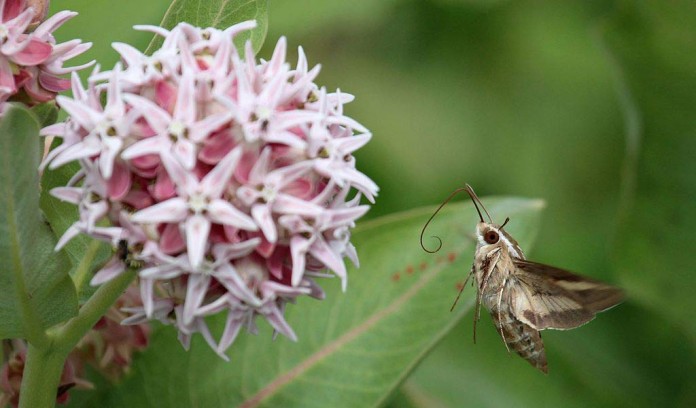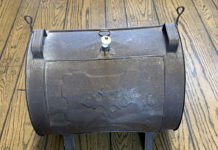
Juvenile hummingbirds began leaving their nests about two weeks ago, so activity at my nectar feeders has surged. Where a month ago, I had four or five hummers coming to my feeders, that number has now swelled to 10 to 12.
And if it turns out to have been a good year for hummers, I might see as many as 20 to 25 draining my feeders every day.
After a few days of seeing so many hummers at feeders and flowers, it’s easy to take them for granted. But if you do, you might miss a real treat.
Look closely
When you scan a group of hummingbirds carefully, you might notice that one looks a little different. It’s smaller, but it flies like a hummingbird and feeds like a hummingbird. It may be a hummingbird moth.
Hummingbird moths are a type of sphinx moth. Every summer readers send me detailed descriptions and photos of strange hummingbird-like creatures. Most report that it’s fuzzy, looks like a bee, has antenna, and a long beak.
The first and best clue is the antenna. If it has antenna, it’s an insect, not a bird.
Hummingbird moths hover at flowers and sip nectar through a long unfurled proboscis.
About 100 species of sphinx moths inhabit North America. Many are active at dusk and after dark, when they sip nectar from tubular flowers that remain open at night. In return for the meal, sphinx moths pollinate flowers.
The “beak” is actually a long, flexible tube (the proboscis) that stays coiled under the head when the moth is not feeding.
Local species
Several species are likely to be seen locally. One is small with a body that’s only about an inch long. Others are larger, but still smaller than hummers.
Clearwing hummingbird moths are among the smallest of these fascinating insects. I usually see the first ones in June. If I approach slowly and use binoculars, I can see its proboscis uncoil as it approaches each flower. And its transparent naked wings are obvious.
The white-lined sphinx has a long white line extending the length of its front wings and a rosy colored stripe across the rear wing. Its heavy brown body tapers to a point at each end and has a series of dark bands across its abdomen.
Hornworms
The other common local species is known by the name of its caterpillar and is probably more familiar to readers who garden. Tomato hornworms, those fat, green, fleshy caterpillars that eat tomatoes and their leaves, eventually transform into five-spotted hawk-moths.
Adult tomato hornworms are large, gray moths with wingspans of about four inches. A series of five or six bright orange spots on each side of the abdomen helps identify them.
The caterpillars are called hornworms because of the fleshy, spine-like “horn” that projects upward from the rear end of the body. Though the spine looks like a stinger, it’s quite harmless.
When alarmed, hornworms erect themselves in a stiff, sphinx-like pose — hence the general name of this group of moths.
A tomato hornworm has eight V-shaped white marks on its sides, and its horn is black. Other species are marked differently and may have different colored horns.
If you find hornworms covered with small white capsules, don’t be alarmed. These white objects are pupal cases of tiny wasps that parasitize hornworms and control their numbers. They are harmless to people.
By the time these pupae hatch, the hornworm will be dead. The larval wasps consumed the hornworm from the inside before emerging to pupate.
Life cycle
The life cycle of sphinx moths is simple and includes a complete metamorphosis.
Early in the summer, females lay up to 300 eggs on the underside of leaves of tomatoes and other host plants such as peppers, potatoes, petunias, and geraniums.
In about a week the eggs hatch and caterpillars emerge. They feed furiously for the next four to six weeks and molt five times before burrowing underground to pupate for the winter.
The following June or July adults emerge and repeat the life cycle.













My family and I really enjoy seeing these Hummingbird Moths, but I don’t want to have them ravishing my garden. Is there another suitable host plant I may relocate them to? My honeysuckle or clematis lace vine is much larger so the damage would be less detrimental. I host a number of monarches and keep them protected- so it’s only natural for me to want to help these little guys too- we don’t have many, in fact we may only see 1 or 2 each summer.